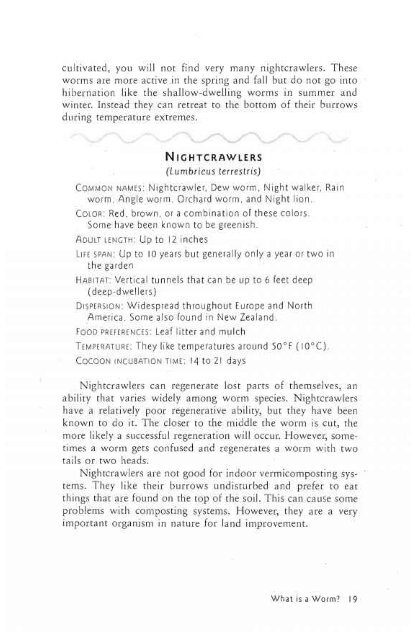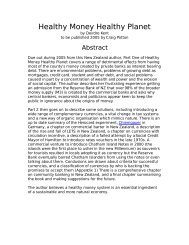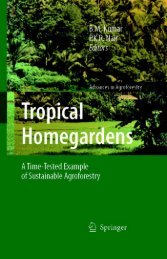Loren Nancarrow and Janet Hogan Taylor - library.uniteddiversity ...
Loren Nancarrow and Janet Hogan Taylor - library.uniteddiversity ...
Loren Nancarrow and Janet Hogan Taylor - library.uniteddiversity ...
You also want an ePaper? Increase the reach of your titles
YUMPU automatically turns print PDFs into web optimized ePapers that Google loves.
cultivated, you will not find very many nightcrawlers. These<br />
worms are more active in the spring <strong>and</strong> fall but do not go into<br />
hibernation like the shallow-dwelling worms in summer <strong>and</strong><br />
winter. Instead they can retreat to the bottom of their burrows<br />
during temperature extremes.<br />
NIGHTCRAWLERS<br />
(Lumbricus terrestris)<br />
COMMON NAMES: Nightcrawler, Dew worm, Night walker, Rain<br />
worm, Angle worm, Orchard worm, <strong>and</strong> Night lion.<br />
COLOR: Red, brown, or a combination of these colors.<br />
Some have been known to be greenish.<br />
ADULT LENGTH: Up to 12 inches<br />
LIFE SPAN: Up to 10 years but generally only a year or two in<br />
the garden<br />
HABITAT: Vertical tunnels that can be up to 6 feet deep<br />
(deep-dwellers)<br />
DISPERSION: Widespread throughout Europe <strong>and</strong> North<br />
America. Some also found in New Zeal<strong>and</strong>.<br />
FOOD PREFERENCES: Leaf litter <strong>and</strong> mulch<br />
TEMPERATURE: They like temperatures around 50°F (I0°C).<br />
COCOON INCUBATION TIME: 14 to 21 days<br />
Nightcrawlers can regenerate lost parts of themselves, an<br />
ability that varies widely among worm species. Nightcrawlers<br />
have a relatively poor regenerative ability, but they have been<br />
known to do it. The closer to the middle the worm is cut, the<br />
more likely a successful regeneration will occur. However, sometimes<br />
a worm gets confused <strong>and</strong> regenerates a worm with two<br />
tails or two heads.<br />
Nightcrawlers are not good for indoor vermicomposting systems.<br />
They like their burrows undisturbed <strong>and</strong> prefer to eat<br />
things that are found on the top of the soil. This can cause some<br />
problems with composting systems. However, they are a very<br />
important organism in nature for l<strong>and</strong> improvement.<br />
What s a Worm? 19














